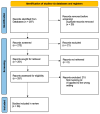Risk Management and Patient Safety in the Artificial Intelligence Era: A Systematic Review
- PMID: 38470660
- PMCID: PMC10931321
- DOI: 10.3390/healthcare12050549
Risk Management and Patient Safety in the Artificial Intelligence Era: A Systematic Review
Abstract
Background: Healthcare systems represent complex organizations within which multiple factors (physical environment, human factor, technological devices, quality of care) interconnect to form a dense network whose imbalance is potentially able to compromise patient safety. In this scenario, the need for hospitals to expand reactive and proactive clinical risk management programs is easily understood, and artificial intelligence fits well in this context. This systematic review aims to investigate the state of the art regarding the impact of AI on clinical risk management processes. To simplify the analysis of the review outcomes and to motivate future standardized comparisons with any subsequent studies, the findings of the present review will be grouped according to the possibility of applying AI in the prevention of the different incident type groups as defined by the ICPS.
Materials and methods: On 3 November 2023, a systematic review of the literature according to the Preferred Reporting Items for Systematic Reviews and Meta-Analyses (PRISMA) guidelines was carried out using the SCOPUS and Medline (via PubMed) databases. A total of 297 articles were identified. After the selection process, 36 articles were included in the present systematic review.
Results and discussion: The studies included in this review allowed for the identification of three main "incident type" domains: clinical process, healthcare-associated infection, and medication. Another relevant application of AI in clinical risk management concerns the topic of incident reporting.
Conclusions: This review highlighted that AI can be applied transversely in various clinical contexts to enhance patient safety and facilitate the identification of errors. It appears to be a promising tool to improve clinical risk management, although its use requires human supervision and cannot completely replace human skills. To facilitate the analysis of the present review outcome and to enable comparison with future systematic reviews, it was deemed useful to refer to a pre-existing taxonomy for the identification of adverse events. However, the results of the present study highlighted the usefulness of AI not only for risk prevention in clinical practice, but also in improving the use of an essential risk identification tool, which is incident reporting. For this reason, the taxonomy of the areas of application of AI to clinical risk processes should include an additional class relating to risk identification and analysis tools. For this purpose, it was considered convenient to use ICPS classification.
Keywords: artificial intelligence; clinical risk management; machine learning; patient safety.
Conflict of interest statement
The authors declare no conflicts of interest.
Figures
Similar articles
-
The future of Cochrane Neonatal.Early Hum Dev. 2020 Nov;150:105191. doi: 10.1016/j.earlhumdev.2020.105191. Epub 2020 Sep 12. Early Hum Dev. 2020. PMID: 33036834
-
The Effectiveness of Integrated Care Pathways for Adults and Children in Health Care Settings: A Systematic Review.JBI Libr Syst Rev. 2009;7(3):80-129. doi: 10.11124/01938924-200907030-00001. JBI Libr Syst Rev. 2009. PMID: 27820426
-
Artificial Intelligence in Head and Neck Cancer: A Systematic Review of Systematic Reviews.Adv Ther. 2023 Aug;40(8):3360-3380. doi: 10.1007/s12325-023-02527-9. Epub 2023 Jun 8. Adv Ther. 2023. PMID: 37291378 Free PMC article.
-
Accuracy of Artificial Intelligence Models in Dental Implant Fixture Identification and Classification from Radiographs: A Systematic Review.Diagnostics (Basel). 2024 Apr 11;14(8):806. doi: 10.3390/diagnostics14080806. Diagnostics (Basel). 2024. PMID: 38667452 Free PMC article. Review.
-
Beyond the black stump: rapid reviews of health research issues affecting regional, rural and remote Australia.Med J Aust. 2020 Dec;213 Suppl 11:S3-S32.e1. doi: 10.5694/mja2.50881. Med J Aust. 2020. PMID: 33314144
Cited by
-
Is It Still Time for Safety Walkaround? Pilot Project Proposing a New Model and a Review of the Methodology.Medicina (Kaunas). 2024 May 29;60(6):903. doi: 10.3390/medicina60060903. Medicina (Kaunas). 2024. PMID: 38929520 Free PMC article.
-
Development and assessment of the AE-RADS standardized grid for specifically evaluating adverse events in diagnostic radiology and teleradiology.BMC Med Imaging. 2025 May 1;25(1):143. doi: 10.1186/s12880-025-01670-9. BMC Med Imaging. 2025. PMID: 40312700 Free PMC article.
-
Advancing Pharmacy Practice: The Role of Intelligence-Driven Pharmacy Practice and the Emergence of Pharmacointelligence.Integr Pharm Res Pract. 2024 Aug 26;13:139-153. doi: 10.2147/IPRP.S466748. eCollection 2024. Integr Pharm Res Pract. 2024. PMID: 39220215 Free PMC article.
-
Development and evaluation of a model for predicting the risk of healthcare-associated infections in patients admitted to intensive care units.Front Public Health. 2024 Sep 12;12:1444176. doi: 10.3389/fpubh.2024.1444176. eCollection 2024. Front Public Health. 2024. PMID: 39329001 Free PMC article.
-
The era of increasing cancer survivorship: Trends in fertility preservation, medico-legal implications, and ethical challenges.Open Med (Wars). 2025 Feb 12;20(1):20251144. doi: 10.1515/med-2025-1144. eCollection 2025. Open Med (Wars). 2025. PMID: 39958979 Free PMC article.
References
-
- World Health Organization Fact Sheets. Patient Safety. [(accessed on 2 January 2024)]. Available online: https://www.who.int/news-room/facts-in-pictures/detail/patient-safety.
Publication types
LinkOut - more resources
Full Text Sources


